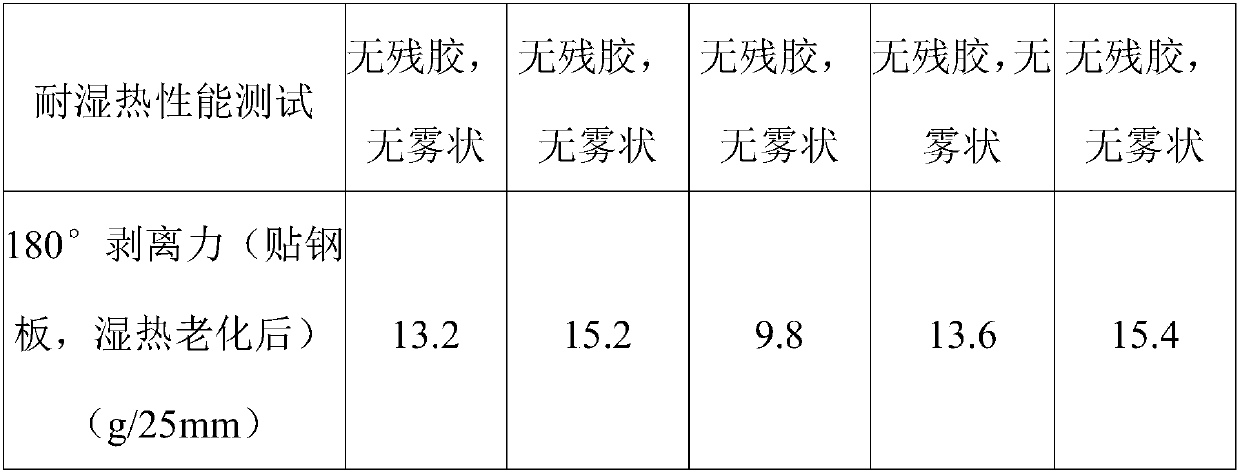Pressure-sensitive adhesive protection film for mobile phone screen and preparation method of pressure-sensitive adhesive protection film
A pressure-sensitive adhesive protective film, mobile phone screen technology, applied in the field of pressure-sensitive adhesives, can solve the problems of poor moisture and heat resistance, wrinkle, not easy to tear, etc., achieves good moisture and heat resistance, easy peeling, and increased cohesive strength. Effect
- Summary
- Abstract
- Description
- Claims
- Application Information
AI Technical Summary
Problems solved by technology
Method used
Image
Examples
Embodiment 1
[0031] (1) Weigh 10g of methyl acrylate, 6g of decyl acrylate, 12g of tridecyl methacrylate, 2.5g of acrylic acid, 2.5g of 4-hydroxybutyl acrylate, vinyl tris(2-methoxyethoxy) Silane 2g, ethyl acetate 65g and azobisisobutyronitrile 0.175g.
[0032] Add 10g of methyl acrylate, 6g of decyl acrylate, 12g of tridecyl methacrylate, 2.5g of acrylic acid, 2.5g of 4-hydroxybutyl acrylate, and 2g of vinyl tris(2-methoxyethoxy)silane into the reaction Mix well in the container, add 42.25g (65%) ethyl acetate and mix until completely dissolved, then heat to 80°C, then add 0.07g (40%) azobisisobutyronitrile to react;
[0033] (2) After mixing 9.75g (15%) ethyl acetate and 0.06g (35%) azobisisobutyronitrile evenly, slowly add it dropwise to the mixed solution of step (1), the control time is 1.5h, drop Carry out insulation reaction after adding, and the time is 2h;
[0034] (3) Add the remaining 0.045 g of azobisisobutyronitrile and the remaining 13 g of ethyl acetate to the mixed soluti...
Embodiment 2
[0038] (1) Weigh 3g of methyl acrylate, 1g of isobutyl methacrylate, 16.5g of butyl acrylate, 13g of lauryl methacrylate, 0.5g of acrylic acid, 0.5g of 2-hydroxy acrylate, vinyl tris(2-methyl 0.5 g of oxyethoxy) silane, 65 g of toluene and 0.035 g of azobisisobutyronitrile.
[0039] Methyl acrylate 3g, isobutyl methacrylate 1g, butyl acrylate 16.5g, lauryl methacrylate 13g, acrylic acid 0.5g, 2-hydroxy acrylate 0.5g, vinyl tris(2-methoxyethoxy Add 0.5 g of silane into the reaction vessel and mix evenly, add 29.25 g (45%) of toluene and mix until completely dissolved, then heat to 66°C, then add 0.01 g (30%) of azobisisobutyronitrile for reaction;
[0040] (2) After mixing 16.25g (25%) toluene and 0.007g (20%) azobisisobutyronitrile evenly, slowly add it dropwise to the mixed solution of step (1), the control time is 0.5h, and the dropwise addition ends Carry out insulation reaction afterward, the time is 2h;
[0041] (3) Add the remaining 0.018 g of azobisisobutyronitrile an...
Embodiment 3
[0045](1) Weigh 5g of methyl acrylate, 2g of cyclohexyl methacrylate, 16g of butyl acrylate, 8g of decyl methacrylate, 1.5g of acrylic acid, 1.5g of caprolactone acrylate, r-(methacryloyl 1 g of oxy)propyltrimethoxysilane, 5 g of acetone, 15 g of toluene, 45 g of ethyl acetate, and 0.105 g of azobisisobutyronitrile.
[0046] Methyl acrylate 5g, cyclohexyl methacrylate 2g, butyl acrylate 16g, decyl methacrylate 8g, acrylic acid 1.5g, caprolactone acrylate 1.5g, r-(methacryloxy)propyl Add 1g of trimethoxysilane into the reaction vessel and mix evenly, add 8.25g (55%) toluene, 24.75g (55%) ethyl acetate, 2.75g (55%) acetone and mix until completely dissolved, then heat to 66°C, and then Add 0.04g (35%) azobisisobutyronitrile to react;
[0047] (2) After mixing 3g (20%) toluene, 9g (20%) ethyl acetate, 1g (20%) acetone and 0.03g (28%) azobisisobutyronitrile, slowly add it dropwise to step (1 ) in the mixed solution, the control time is 1h, and the insulation reaction is carried ...
PUM
 Login to View More
Login to View More Abstract
Description
Claims
Application Information
 Login to View More
Login to View More - R&D
- Intellectual Property
- Life Sciences
- Materials
- Tech Scout
- Unparalleled Data Quality
- Higher Quality Content
- 60% Fewer Hallucinations
Browse by: Latest US Patents, China's latest patents, Technical Efficacy Thesaurus, Application Domain, Technology Topic, Popular Technical Reports.
© 2025 PatSnap. All rights reserved.Legal|Privacy policy|Modern Slavery Act Transparency Statement|Sitemap|About US| Contact US: help@patsnap.com


